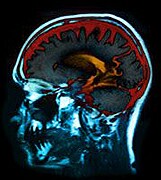Rat model finding awaits testing in humans
THURSDAY, Aug. 6, 2015 (HealthDay News) — Removal of waste, including soluble amyloid β (Aβ), from the brain may be most efficient in the lateral versus the prone position, according to an experimental study published in the Aug. 5 issue of the Journal of Neuroscience.
Hedok Lee, Ph.D., from Stony Brook University in New York, and colleagues examined whether body posture impacts cerebrospinal fluid (CSF)-interstitial fluid (ISF) exchange efficiency. They quantified CSF-ISF exchange rates using dynamic-contrast-enhanced magnetic resonance imaging (MRI) and kinetic modeling in the brains of rodents in supine, prone, or lateral positions. Fluorescence microscopy and radioactive tracers were used to validate the MRI data and assess the influence of body posture on clearance of Aβ.
The researchers found that glymphatic transport was most efficient in the lateral versus the supine or prone positions. Transport was characterized by “retention” of the tracer, slower clearance, and more CSF efflux along larger caliber cervical vessels in the prone position, in which the rat’s head was in the most upright position (mimicking posture during the awake state). Glymphatic transport and Aβ clearance were superior in the lateral and supine positions in optical imaging and radiotracer studies.
“We propose that the most popular sleep posture (lateral) has evolved to optimize waste removal during sleep and that posture must be considered in diagnostic imaging procedures developed in the future to assess CSF-ISF transport in humans,” the authors write.
Copyright © 2015 HealthDay. All rights reserved.








